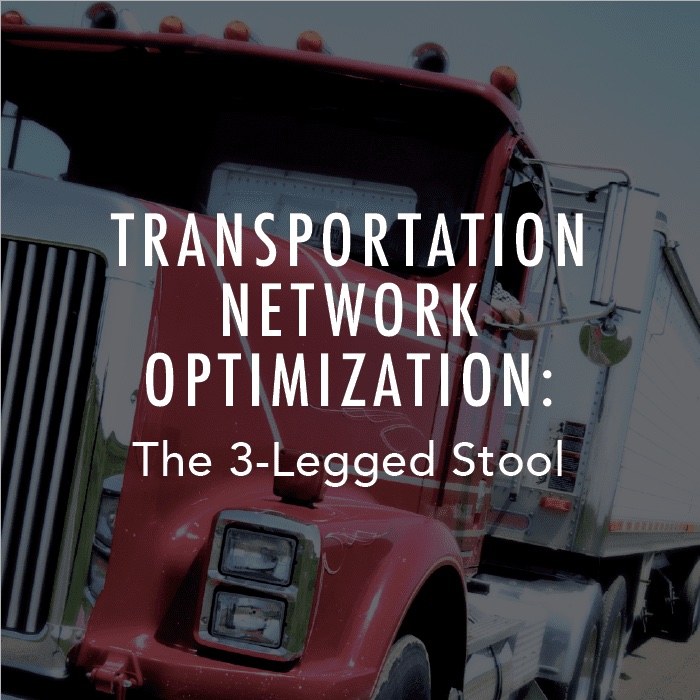Transportation Network Optimization: The 3-Legged Stool

How should leading-edge companies view transportation? Today, leading-edge companies are transforming their process for buying and managing freight capacity from a tactical, frequently siloed, rate-shopping exercise to a holistic, multi-modal, enterprise-wide optimization of their transportation network. This creates an ecosystem where transportation becomes a truly strategic weapon and sustainable competitive advantage. Unfortunately, very few organizations recognize all of the benefits that can come from robust supply chain network optimization and what a strategic transportation partnership can bring them.
The “3-legged stool” of transportation network optimization considers all three core elements of a successful transportation network: price, capacity and service. Pulling out one or more legs of the stool makes the network unstable. During this year’s Shipper Symposium, our Transportation Network Optimization session showcased how Transplace’s Supply Chain Consulting Practice (TSCC) helped a global producer of wood products strategically overhaul and optimize its North American network of transportation capacity, service and spend. Below is a look at that case study and the great results that the process yielded.
Manufacturer Takes Transportation Management to the Next Level
The wood product manufacturer recently partnered with Transplace, with the objective of building a more strategic approach to sourcing transportation capacity and managing their core carrier base. The joint project team executed a Strategic Transportation Optimization (STO) project, which included:
- Creating a freight spend baseline
- Developing a comprehensive capacity sourcing RFP
- Executing a multi-round sourcing event
- Building a set of business rules and constraints
- Designing and producing a comprehensive set of alternative scenarios to test for optimal outcome
- Producing an optimized routing strategy that could be operationalized
- Generating more than $5M in annual savings
With a more centralized methodology for its transportation management as the desired outcome, the manufacturer wanted to take a more strategic approach to centralized and standardized sourcing.
Executing a Network-Wide RFP and Building a Baseline
Prior to this project, the manufacturer’s operations had been localized, using minimally structured routing guides or auto-tendering. Restructuring and optimizing its operations required planning and executing the company’s first-ever network-wide RFP – with a carrier base made up largely of regional owner-operators having little experience with technology-enabled sourcing systems.
It was also critical to build a strategic plan and establish the first company-wide freight spend baseline, which would allow for the optimization of the manufacturer’s routing strategy to achieve its internal goal of $5M in freight cost reduction. And because shipment transaction data was stored across three legacy systems, more than 75,000 shipment records needed to be consolidated, cleansed and validated to ensure the data was accurate and usable.
In addition to establishing this freight spend baseline, TSCC needed to understand how the manufacturer operated. This was achieved by conducting on-site discovery with the company’s regional transportation managers and dispatching staff to get a firsthand look at its transportation operations.
Because most of the manufacturer’s carrier base had limited experience with technology-enabled sourcing or RFPs, this process was extended to the incumbent carrier base as well. Several extensive, hands-on training and briefing sessions with carrier stakeholders helped communicate how this new approach would enable optimization of the manufacturer’s network as well as theirs – and guaranteed carrier compliance with RFP requirements. This not only helped carriers navigate the process, but ensured that the manufacturer would be partnered with the right carriers, the right service and the right capacity – all at the right price.
After evaluating RFP responses and conducting negotiations, Transplace worked with the manufacturer to create an optimized network strategy, covering high-level planning, as well as carrier routing at the lane-level. Transplace also managed the communications and implementation of the awarding strategy as well as the assembly of a routing guide.
The 3-Legged Stool Yields Impressive Results
Establishing a strategic, technology-based approach to sourcing has led to significant operational improvements, as well as cost savings for the manufacturer. As a result of this project, the manufacturer:
- Gained greater visibility into freight flows and spend – By consolidating and validating shipment level data from across its three ERP systems, the manufacturer – and its carrier partners – gained visibility into their transportation network by facility, lane, region and mode. This not only enabled the manufacturer to achieve centralization, it also provided the incumbent carriers with the ability to shift their capacities and offer improved service going forward.
- Developed an optimized routing strategy – Executing a technology-enabled, network-wide RFP and iterative scenario analysis, enabled the manufacturer to create a centralized optimal routing strategy.
- Reduced carrier base by 61% – By optimizing its carrier selection, the manufacturer reduced is carrier base from 270 to 105 carriers. The manufacturer benefitted from strengthening their incumbent carrier relationships by empowering the network sustainability of all parties involved.

Large-scale, complex, network-based projects, such as this case, will identify value in the network. They will present the opportunity to both save money and improve service to customers. But identifying value is only the first chapter of the story. The next chapter, implementation, is where the rubber meets the road and the value identified is turned into the value realized.
Far too often implementation is not well-planned or well-executed, with benefits and compliance not being tracked and performance KPIs and metrics not being monitored or measured. The inevitable result is a shortfall in benefits versus what could have been achieved with proper planning, tools and execution.
Through this project, the manufacturer also gained access to network data and a blueprint for the optimized sourcing process that will be the foundation for the next time a similar project is undertaken. This, then, becomes the launch-point for a continuous improvement process that will continue driving benefits well into the future.
How is the “3-legged stool” impacting your business operations?



